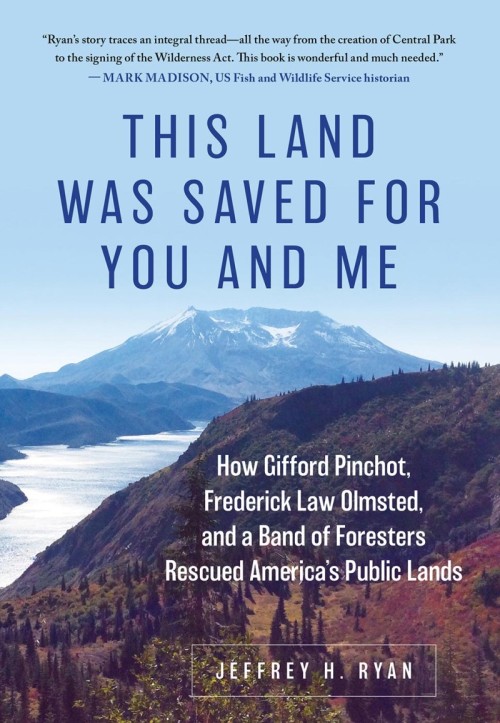by Jeffrey H. Ryan
Stackpole Books, 2022
How Gifford Pinchot, Frederick Law Olmsted, and a Band of Foresters Rescued America’s Public Lands
In This Land Was Saved for You and Me: How Gifford Pinchot, Frederick Law Olmsted, and a Band of Foresters Rescued America’s Public Lands, Jeffrey H. Ryan takes us back to the late 1800s, before there were national forests, national parks, or wilderness areas. When many believed that America’s forests were limitless, and cut-and-run logging was common. When the concept of managing a forest was unheard of, and anyone who wanted to be a professional forester had to go to Europe to get that training.
Ryan concentrates on the foresters and others closely connected to the land who laid the groundwork for the eventual establishment of national forests, parks, and wilderness areas. He tells a story of perseverance, personality clashes, public relations, and politics. Two key figures whom Ryan highlights are Frederick Law Olmsted, the co-designer of New York City’s Central Park and one of the founders of American landscape architecture, and Gifford Pinchot, the pioneering forester who became the first head of the U.S. Forest Service.
Ryan notes the influence of forestland on Olmsted’s aesthetics. His design focus on natural scenery (as opposed to built features), Ryan writes, “was an idea that took root when Olmsted was a child, during family sojourns to the Green Mountains of Vermont, the White Mountains of New Hampshire, and as far west as Niagara Falls.” In a report he wrote supporting the preservation of Yosemite – decades before Yosemite became a national park – Olmsted took that idea much further, arguing that any human construction should be absolutely minimized to preserve the area’s natural beauty.
Ryan also describes the Biltmore Estate’s role in the development of American forestry. In 1888, George Vanderbilt hired Olmsted to develop a plan for what to do with an expanse of clear-cut property he was acquiring in Asheville, North Carolina, which would become the Biltmore Estate. Olmsted’s plan included reforesting the property, and he recommended Gifford Pinchot, who had studied forestry in France, to manage it. Under Pinchot and later, Carl Schenk, the estate became a model for forestry management and the site of the first forestry school in the United States. Pinchot was “determined to have his management of the Biltmore Forest ‘prove what America did not yet understand, that trees could be cut and the forest preserved at one and the same time.’”
Ryan also takes us to New York State in the 1880s, where the state took possession of hundreds of thousands of acres that loggers had unsustainably cut and abandoned. Those abuses led to the creation of Adirondack Park, where logging is prohibited in many areas. Decades later, when there was an attempt to build dams within the park, the Wilderness Society successfully led an effort to stop it, which was a boost for both the society’s influence and national conservation endeavors.
While early foresters were opposed to irresponsible, cut-and-run logging, over time they and others wanting to save the forests often fell into competing camps – reflecting the distinct goals of establishing forests, parks, and wilderness areas. Pinchot was firmly in the national forest camp, wanting to protect and manage forests as natural resources to serve society. Others, including John Muir, the Sierra Club, and the Wilderness Society, argued for the preservation of forests free of logging and other extraction of resources.
Ryan set out to show how foresters contributed to the establishment of our national forests, parks, and wilderness areas, which he did to good effect; however, the title raises a broader ownership question. Although the longer history of the land is beyond the scope of this book, it would have been beneficial to acknowledge that these 19th-century debates largely ignored the interests and perspectives of the lands’ original, native inhabitants.


